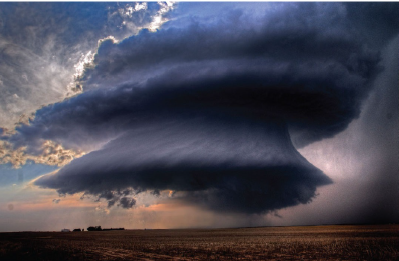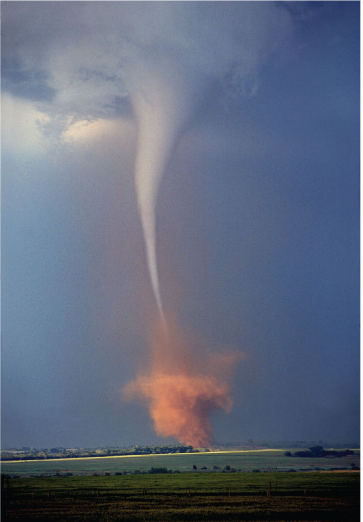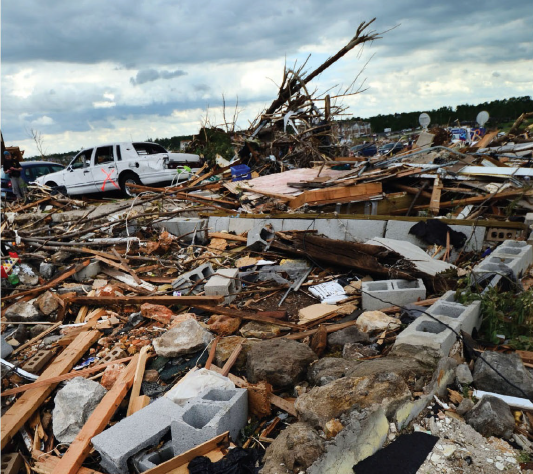Introduction
By definition, a tornado is an intense wind in a rapid rotational motion, which forms a funnel-shaped column. Tornadoes are weather events that occur as a storm and are believed to be the most violent (Amezquita, Valtierra & Adeli, 2017). They are the most hazardous natural disasters causing significant damages and losses in regions such as the Midwestern United States. Research shows that the United States records the highest number of tornadoes in the world (Tippett, 2018). As well, United States’ tornadoes are considered strong and more damaging than those experienced in other parts of the world (Fricker & Elsner, 2019). Due to the severity of tornadoes, the paper seeks to explore the causes and consequences of these events, and how awareness is created of foreseen events in today’s world.
Meteorological Causes and Development of Tornadoes
Process of Tornado Formation
Shearing of wind directions is considered a perfect condition for tornado development. An instance of the shearing of wind direction occurs when the southeast surface winds approach the high-blowing west winds. Zones of significant wind shear also occur at a hurricane’s right-forward quadrant, and this is why a weak hurricane can cause dozens of tornadoes as long as these conditions exist (Dalton, 2018). Thunderstorms, in addition, create ample conditions leading to the formation of tornadoes.
The shear in wind direction creates horizontal current rolls during a thunderstorm when cold air dives under an advancing warm humid air. The warm air on the surface drags these rolling currents rotating on a horizontal axis into a vertical position as it rises, forcing them to rotate on a vertical axis. The drag produces an updraft forming a rotation cell in the thunderstorm that extends up to 10km in width (Dalton, 2018). A wall cloud whose walls tend to be steep descends from the main cloud whose base is nearly horizontal, a sign that a supercell is forming as shown in Figure 1. The wall cloud rotates at slow motions under the main cloud base as the cell sags. A mesocyclone, which is a funnel-shaped cloud rotating in an anticlockwise direction at a high speed, then forms within or adjacent to the wall cloud (Dalton, 2018). The mesocyclone accelerates and tightens, extending downwards as the heavy rains and hails of the storm subside. A tornado is then formed when these rotating mesocyclones descend to ground level as shown in Figure 2.


Tornadoes are powered by the latent heat of vaporization, the heat released during raindrop formation after the condensation of water vapor in the atmosphere. During a storm, the large amount of condensing water vapor releases large amounts of latent heat into the atmosphere which is localized in the condensation area. The localization of this heat energy creates an unstable zone that maintains the upward motion of air, thereby fueling tornadoes.
Classification of Tornadoes and Their Consequences
Tornadoes can be classified depending on their severity, which is dependent on the speed of the internal winds and the damages they cause. A Fujita scale with a rating from zero to five is used to categorize a tornado (Tippett, 2018). Two types of scales are used and include the Fujita Scale with a range of F0 – F5 and the Enhanced Fujita Scale whose rating is EF0 – EF5. These measurement scales categorize tornadoes as gale, moderate or weak, significant or strong, severe, devastating, and incredible, as shown in Table 1 and Table 2 below. EF0 or F0 rated tornadoes are less destructive, while EF5 or F5 rated ones are catastrophic.
Some of the devastating consequences of tornadoes were experienced in Alabama when an EF4 tornado hit the region in the year 2011. The weather event led to the loss of people’s lives as well as damages to property in the affected areas (Anderson & Brooks 2019). In addition, fourteen tornadoes of EF0 and EF1 ratings occurred in Illinois in the year 2020 causing minor damage to structures (National Oceanic and Atmospheric Administration, 2020). Figure 3 below shows some of the damages caused by this weather event in various parts of the world.


Prospects of Developing Tornadoes
The study of tornadoes has enabled weather experts to predict occurrences successfully. In most cases, tornadoes accompany over-land moving weather events such as hurricanes and storms. Various weather changes may be used as clues and warnings of a developing tornado. For instance, the formation of a sightseeing wall cloud is a warning that a tornado is about to form (Warren, 2018). As well, Mammatus clouds signal an imminent tornado. They are sagging groups of round-pouched clouds below the cloud base. A developing supercell also warns against these weather hazards (Warren, 2018). Supercells are giant thunderclouds with broad mushroom-shaped tops and are characterized by large masses of warm air in a rotational motion that rapidly rises into the clouds.
The National Oceanic and Atmospheric Administration, NOAA, uses tools such as wind profilers and radars to predict these events. During stormy weather, storm spotters are keen on severe storms, and a warning of a developing tornado is issued immediately it is spotted or when the Doppler radars indicate the presence of rotations or vorticity (Rauber & Nesbitt, 2018). Formations of hook-shaped bands on weather radars signify a developing tornado. A hook echo is a condition that favors tornado development and implies a collision of two fronts in a low-pressure center of a substantial strength (Rauber & Nesbitt, 2018). A warning of a developing tornado is also perceived at its initial stages of development when it narrows to become ropelike in some instances. The public is warned of such developments through radio and television broadcasts, and tornado sirens.
People in regions prone to tornadoes such as the Midwestern United States are advised to stay alert to NOAA’s warnings. It is recommended that safe places be established in homes where the family can safely shelter themselves in the event of this hazard (Dalton, 2018). People are encouraged to find shelter underground or on the lowest floors of buildings without basements but away from windows.
Conclusion
Tornadoes are violent natural weather events that occur in the form of storms. They result from shearing winds and are energized by the latent heat of vaporization which is released into the atmosphere by condensing water vapors. Tornadoes are classified into six categories depending on their internal wind speed and the damages they cause. These weather events have ratings between zero and five on the Fujita Scale or Enhanced Fujita Scale. A zero rating implies that the event causes insignificant damages while a rating of five is an implication of a catastrophic event. Changes in weather patterns and the use of tools such as Dopler radars are useful in predicting tornadoes. People in tornado-prone areas are advised to stay alert to warnings and develop tornado safe places in which they can find shelter in the event of such hazards.
References
Amezquita, J., Valtierra, M., & Adeli, H. (2017). Current efforts for prediction and assessment of natural disasters. Scientia Iranica, 24(6), 2645-2664. Web.
Anderson, A., & Brooks, H. (2019). Tornado Fatalities: An Environmental Perspective. Weather and Forecasting, 34(6), 1999-2015. Web.
Dalton, F. (2018). Tsunamis and hurricanes: Natural disasters. Library Press. Web.
Fricker, T., & Elsner, J. (2019). Unusually devastating tornadoes in the United States: 1995–2016. Annals of the American Association of Geographers, 110(3), 724-738. Web.
Mahieu, P., & Wesolek, E. (2016). Tornado rating in Europe with the EF-Scale. Keraunos.org.
National Oceanic and Atmospheric Administration. Tornadoes – November 2020 | State of the climate | National Centers for Environmental Information (NCEI). Ncdc.noaa.gov. Web.
Rauber, R., & Nesbitt, S. (2018). Radar meteorology (1st ed.). Bell & Bain Ltd.
Tippett, M. (2018). Robustness of relations between the MJO and U.S. tornado occurrence. Monthly Weather Review, 146(11), 3873-3884. Web.
Warren, F. (2018). Wicked weather. Amherst Media.
